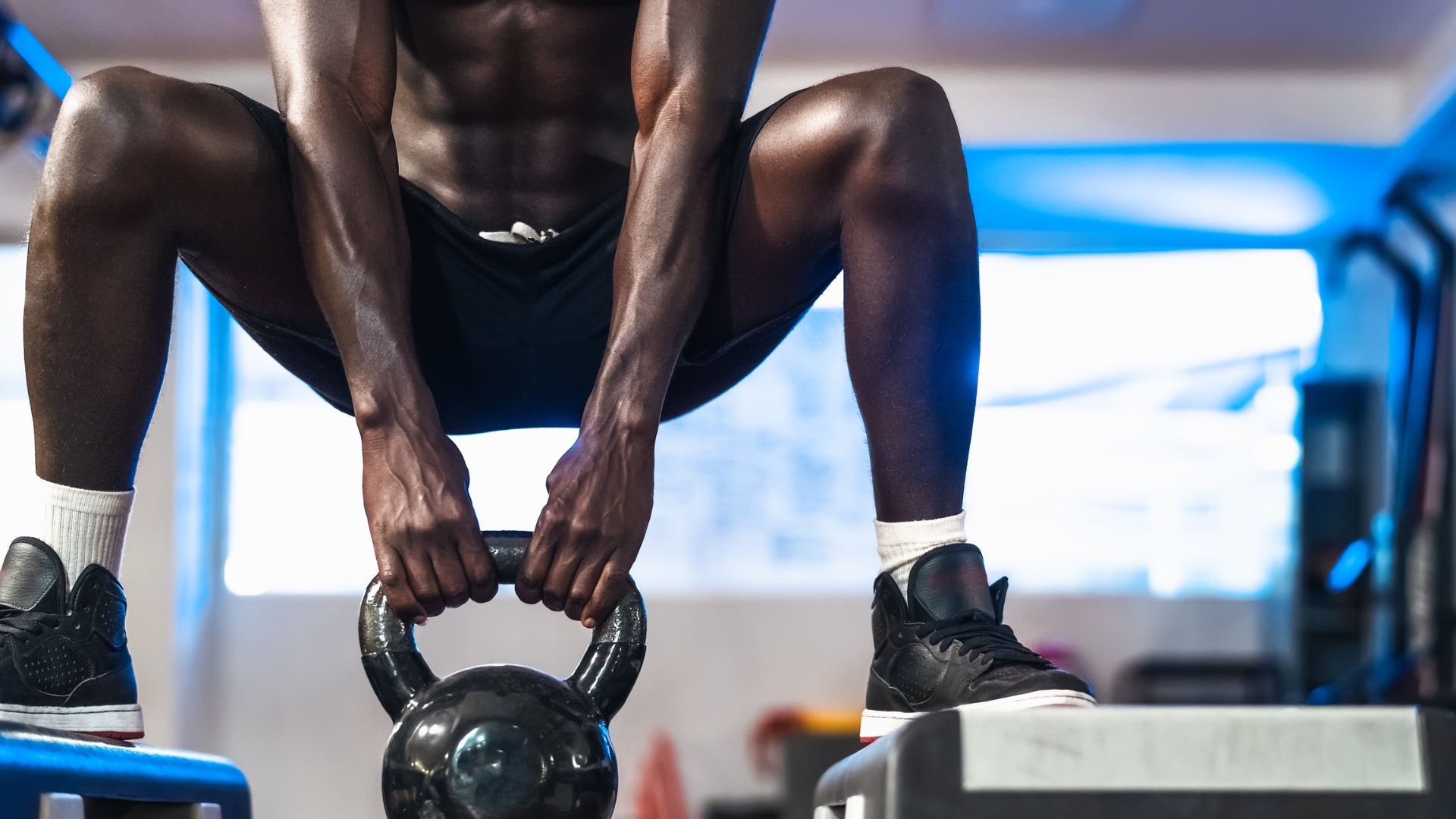Hey there, fitness enthusiasts! Ready to dive into the world of squats and discover which stance is your best bet for those killer quads?
Whether you’re aiming for a sculpted lower body or simply curious about optimizing your squat game, we’ve got you covered.
In this blog post, we’re breaking down the age-old debate: high-bar squat vs. narrow-stance squat. We’ll explore the mechanics, benefits, and how-tos of each stance, all while keeping your comfort and safety front and center. So, let’s lace up our sneakers and get squatting!
Squat stance perfect for quads: how and why?
The choice of squat stance for targeting the quadriceps primarily depends on your body mechanics, mobility, and personal fitness goals. There are generally two main squat stances that are commonly used to emphasize the quadriceps muscles: the high-bar squat and the narrow-stance squat are used.
High-Bar Squat:
Stance: In the high-bar squat, your feet are typically positioned at about shoulder-width apart or slightly wider. Your toes are pointed slightly outward.
Bar Placement: The barbell is positioned on the upper traps or across the shoulders.
Mechanics: This squat style emphasizes a more upright torso position, which can shift the load onto the quadriceps. As you squat down, your knees move forward, and your hips also shift back, allowing for greater knee flexion.
Targeted Muscles: The high-bar squat places a significant amount of stress on the quadriceps due to the more vertical torso angle. It’s effective for targeting the front of your thighs.
Narrow-Stance Squat:
Stance: In the narrow-stance squat, your feet are closer together, often about hip-width apart or slightly wider. Toes may be angled slightly outward.
Bar Placement: The barbell can be positioned either high on the traps or lower on the upper back, depending on your comfort and mobility.
Mechanics: The narrow-stance squat can allow for more knee flexion while still engaging the quadriceps. The torso angle might be slightly more forward compared to the high-bar squat.
Targeted Muscles: This squat variation still emphasizes the quadriceps but also involves the inner thigh muscles (adductors) to a greater extent.
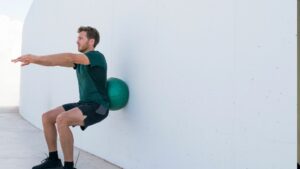
How to Choose:
The choice between these squat stances depends on several factors:
Body Mechanics: Your individual body proportions, joint mobility, and flexibility can influence which stance is more comfortable and effective for you.
Mobility: If you have good ankle and hip mobility, you might find it easier to get into the positions required for the high-bar or narrow-stance squat.
Goals: Consider your fitness goals. If you’re aiming to prioritize quadriceps development, both of these stances can be beneficial. However, the high-bar squat might provide slightly more direct emphasis on the quads due to the more upright torso.
Comfort and Safety: Always prioritize a stance that feels comfortable and safe for your body. Incorrect form can lead to injury.
Remember that while these squat stances can emphasize the quadriceps, squats are compound movements that engage multiple muscle groups.
Therefore, it’s important to have a well-rounded workout routine that includes various squat stances, as well as other exercises, to achieve balanced muscle development.
If you’re new to squatting or want to make significant changes to your routine, consider working with a fitness professional to ensure you’re using proper form and targeting your desired muscle groups effectively.
Explanations.
Let’s delve deeper, let me explain these points mentioned further.
High-Bar Squat:
Stance and Bar Placement.
In the high-bar squat, your feet are positioned approximately shoulder-width apart or slightly wider.
This stance provides a stable base for the movement. Your toes are pointed slightly outward, which helps with maintaining proper alignment as you squat.
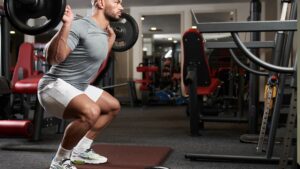
The barbell is placed on your upper traps, which is the muscular area between your neck and shoulders, or across the top of your shoulders.
This high-bar placement allows the bar to be close to your body’s center of gravity.
Mechanics:
The high-bar squat is characterized by an emphasis on maintaining an upright torso throughout the movement. This positioning is achieved by keeping your chest up and your back straight.
As you initiate the squat, your hips shift back and down, and your knees move forward. This combination of hip and knee movement creates a greater knee flexion angle.
Quadriceps Emphasis:
The high-bar squat’s mechanics place a significant portion of the load on your quadriceps muscles, the large muscles located on the front of your thighs.
The emphasis on an upright torso causes your body to remain more vertical compared to other squat variations.
This positioning increases the demand on your quadriceps to extend the knee joint while also providing a decent amount of hip flexion.
Torso Angle:
The more vertical torso angle in the high-bar squat leads to a greater degree of knee flexion compared to other squat stances, such as the low-bar squat.
This increased knee flexion further activates the quadriceps muscles. As you descend into the squat, your thighs move closer to being parallel to the ground or even lower, depending on your flexibility and mobility.
Additional Muscles Involved:
While the primary focus of the high-bar squat is on the quadriceps, it’s worth noting that this movement also engages other muscle groups to support the lift.
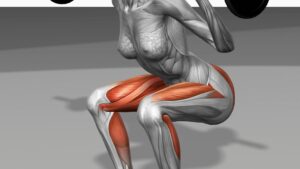
Your glutes, hamstrings, lower back, and core play roles in stabilizing your body and aiding in the upward phase of the squat.
Effectiveness for Quadriceps Development:
Due to its emphasis on the quadriceps, the high-bar squat is considered an effective exercise for targeting the front of your thighs.
It’s particularly beneficial for individuals looking to build strength and size in their quadriceps.
The relatively upright posture helps keep the stress on the quads and can be advantageous for those who want to minimize lower back involvement.
Remember that proper form is crucial when performing the high-bar squat to avoid any strain or injury.
If you’re new to squatting or unsure about your form, consider seeking guidance from a fitness professional or experienced lifter to ensure you’re performing the movement safely and effectively.
Narrow-Stance Squat:
Let’s dive into the explanation of the narrow-stance squat and how it targets the quadriceps and inner thigh muscles:
Stance and Bar Placement.
In the narrow-stance squat, your feet are positioned closer together compared to the wider stance used in other squat variations.
Your feet are typically around hip-width apart or slightly wider, and your toes may be angled slightly outward. This stance allows for a more focused engagement of specific muscle groups.
The barbell can be positioned in a couple of ways: high on the traps, similar to the high-bar squat, or lower on the upper back, which might resemble the placement used in a low-bar squat.
The choice of bar placement can depend on your comfort, mobility, and familiarity with different bar positions.
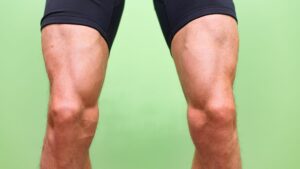
Mechanics:
The narrow-stance squat involves a similar hip and knee movement as other squat variations, but the main difference lies in the stance width.
With your feet closer together, your knees can move more forward during the descent, allowing for increased knee flexion.
This is balanced by a slightly more forward-leaning torso angle compared to the high-bar squat.
Quadriceps and Adductors Emphasis:
The narrow-stance squat places significant emphasis on the quadriceps, much like the high-bar squat.
The increased knee flexion and the forward-leaning torso angle contribute to this emphasis. The quadriceps are responsible for extending the knee joint as you stand up from the squatting position.
In addition to the quadriceps, the narrow-stance squat also involves the inner thigh muscles, known as the adductors, to a greater extent.
The closer stance requires more stabilization from these muscles as you move down and up. This muscle engagement can be particularly noticeable when you ascend from the bottom of the squat, where the adductors play a role in helping you maintain balance and stability.
Balance and Control:
Due to the narrower stance, the narrow-stance squat requires greater balance and control throughout the movement.
The slightly forward torso angle may engage the core muscles more as they assist in maintaining stability.
Effectiveness for Quadriceps and Adductors:
The narrow-stance squat is effective for targeting both the quadriceps and the adductors. This makes it a useful variation for individuals looking to develop strength and size in these muscle groups.
The combination of knee flexion and inner thigh engagement can lead to well-rounded lower body development.
Variation in Muscle Activation:
It’s important to note that while the narrow-stance squat places more emphasis on the adductors compared to the high-bar squat, the degree of muscle activation can vary among individuals.
Factors such as body mechanics, flexibility, and overall strength can influence how intensely you feel these muscles working.
As always, prioritize proper form and start with a weight that allows you to perform the movement safely and effectively.
If you’re unsure about your form or which squat variation is best for your goals, seeking guidance from a fitness professional can provide personalized advice tailored to your needs.
How to Choose:
let’s delve into the influence of body mechanics, joint mobility, and flexibility on the choice between the high-bar and narrow-stance squats:
Body Proportions.
Individuals have varying body proportions, including leg length, torso length, and limb ratios. These proportions can affect how you move during exercises like squats.
For instance, if you have relatively longer limbs, you might find it more challenging to maintain proper form in a narrow-stance squat due to the increased demands on balance. Conversely, shorter limbs might make the narrow-stance squat feel more natural.
In the high-bar squat, body proportions play a role in determining how well you can maintain an upright torso.
Longer torsos may lead to a more forward lean in the high-bar squat, potentially shifting the emphasis away from the quadriceps.
Joint Mobility.
Both ankle and hip mobility play critical roles in executing squats effectively. Good ankle mobility allows you to maintain a stable foot position and enables proper knee tracking.
If you lack ankle mobility, you might struggle to maintain balance and keep your heels on the ground during a narrow-stance squat.
In the high-bar squat, ankle mobility is equally important, especially as your knees move forward during the descent. If your ankles lack the necessary range of motion, it could result in compensations that affect your form and the distribution of force on your muscles.
Hip mobility is particularly crucial for both squat variations. Limited hip mobility can lead to difficulties in achieving proper depth while squatting, potentially causing strain on the lower back or inhibiting your ability to fully activate your quadriceps and adductors.
Flexibility:
Flexibility in your hip flexors, hamstrings, and lower back can significantly impact your squat performance.
Adequate hip flexor flexibility allows for a smoother hip and knee movement during both types of squats.
Tight hip flexors can hinder your ability to keep an upright posture in the high-bar squat or achieve proper depth in the narrow-stance squat.
Hamstring flexibility is essential for proper movement mechanics during the squat.
In the high-bar squat, tight hamstrings might lead to a forward lean as you descend, potentially decreasing quadriceps engagement.
In the narrow-stance squat, hamstring flexibility contributes to maintaining balance and stability throughout the movement.
Mobility and Stance Choice:
Having good ankle and hip mobility makes it easier to get into the required positions for both the high-bar and narrow-stance squats. With proper mobility, you can achieve the necessary depth and maintain appropriate form without compromising stability.
Individuals with excellent mobility might find both squat variations comfortable and effective. On the other hand, limited mobility in specific areas might lead you to favor one squat style over the other. For instance, if your ankles lack mobility, the high-bar squat might be a better option since it involves less forward knee movement.
Ultimately, understanding your body’s mechanics, mobility limitations, and flexibility will guide you toward the squat variation that aligns with your strengths and allows you to perform the movement safely and effectively.
If you’re unsure about your mobility or how to adapt your squat technique, seeking guidance from a fitness professional or physical therapist can provide valuable insights and personalized recommendations.
let’s delve into how considering your fitness goals, comfort, and safety factors into your choice of squat stance:
Fitness Goals.
When selecting a squat stance, your fitness goals play a significant role in determining which variation is most suitable.
If your primary focus is on developing and strengthening your quadriceps muscles, both the high-bar and narrow-stance squats can be effective options.
High-Bar Squat for Quadriceps:
The high-bar squat, with its emphasis on an upright torso and more vertical movement pattern, places a significant amount of stress on the quadriceps.
This can be particularly advantageous for individuals who want to prioritize quadriceps development.
The upright posture in the high-bar squat helps maintain the load on the front of the thighs, making it a more targeted option for this muscle group.
Narrow-Stance Squat for Quadriceps and Adductors:
The narrow-stance squat also engages the quadriceps, albeit with slightly more involvement of the inner thigh muscles (adductors).
This variation might be suitable for individuals who want to work on both their quadriceps and inner thighs simultaneously.
Comfort and Safety.
Comfort and safety should always be paramount when choosing a squat stance. Incorrect form during squats can lead to injuries and hinder your progress. Here’s how comfort and safety factor in:
Choosing a Stance You’re Comfortable With:
It’s essential to select a squat stance that feels natural and comfortable for your body. If a particular stance causes discomfort, strain, or pain, it might not be the right choice for you. Comfort plays a role in maintaining proper form and reducing the risk of injury.
Adapting for Safety:
Each person’s body mechanics are unique, and what works well for one individual might not be suitable for another.
Prioritize safety by starting with a weight that allows you to perform the movement with good form.
If you’re new to squatting or trying a new stance, consider using lighter weights or no weight at all until you’re confident in your technique.
Seeking Professional Guidance:
If you’re uncertain about which squat stance is best for you or how to perform squats safely, consider seeking guidance from a fitness professional.
A personal trainer or coach can assess your form, mobility, and goals to recommend the most suitable squat variation and provide guidance on proper execution.
In other words, the choice between the high-bar and narrow-stance squats should align with your fitness goals, while comfort and safety should be the top priorities.
Whether you’re aiming to prioritize quadriceps development or target multiple muscle groups, selecting a squat stance that feels comfortable and allows you to maintain proper form will contribute to a successful and injury-free squatting experience.
A tabular comparison on this topic here
Here I provide a tabular comparison of the high-bar squat and narrow-stance squat for targeting the quadriceps muscles, explaining how and why each stance is effective:
| Aspect | High-Bar Squat | Narrow-Stance Squat |
|---|---|---|
| Stance | Shoulder-width or slightly wider | Hip-width or slightly wider |
| Toes Position | Slightly outward | Slightly outward |
| Bar Placement | Upper traps or across shoulders | High or low on upper back |
| Torso Angle | More upright | Slightly forward-leaning |
| Knee Movement | Forward as hips shift back | More forward knee movement |
| Quadriceps Emphasis | Significant | Significant |
| Adductor Engagement | Minimal | Greater engagement |
| Hip Mobility Importance | Moderate | Crucial for stability and depth |
| Ankle Mobility Importance | Crucial for maintaining balance | Crucial for maintaining balance |
| Hamstring Flexibility | Affects torso angle and form | Affects balance and depth |
| Comfort and Safety | Suitable for most if executed properly | Suitable with proper balance |
| Fitness Goals | Prioritizes quadriceps development | Quadriceps and adductors emphasis |
Conclusion.
In conclusion, the choice between the high-bar squat and narrow-stance squat for targeting the quadriceps depends on factors such as body mechanics, mobility, and fitness goals.
The high-bar squat emphasizes quadriceps with its upright torso and forward knee movement, while the narrow-stance squat engages both quadriceps and adductors due to a closer stance and forward-leaning torso.
Prioritizing comfort, safety, and proper form is essential for effective and injury-free squatting. It’s advisable to assess your individual characteristics and seek professional guidance to determine the best squat stance that aligns with your objectives and physical capabilities.

Hey there, it’s Mike Rrsq, the Editor-in-Chief over at Jsquat.com, and I’m absolutely obsessed with all things squat fitness! I’ve been lucky enough to get some serious recognition for my work in this field. With a solid background in the fitness and wellness industry, I’ve been there right from the get-go, helping shape this website into what it is today.
You see, I’m not just the boss around here; I’m also a passionate contributor. I love sharing my insights through my articles, and trust me, they’re not your run-of-the-mill stuff. Each piece I write is a labor of love, filled with my expertise and real-world experience in the fitness universe. So, if you’re into fitness and looking for some inspiration, you’re in the right place!

